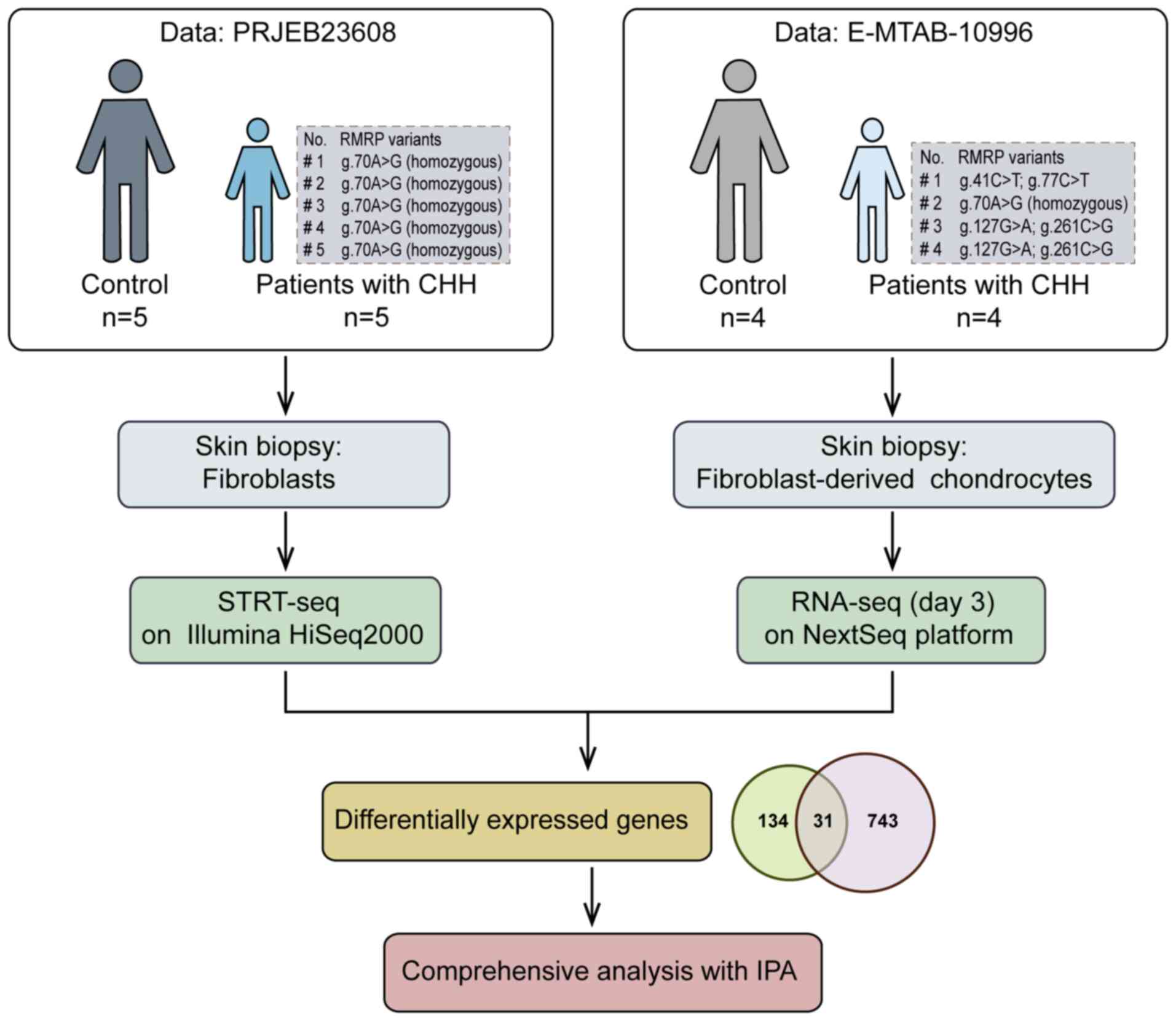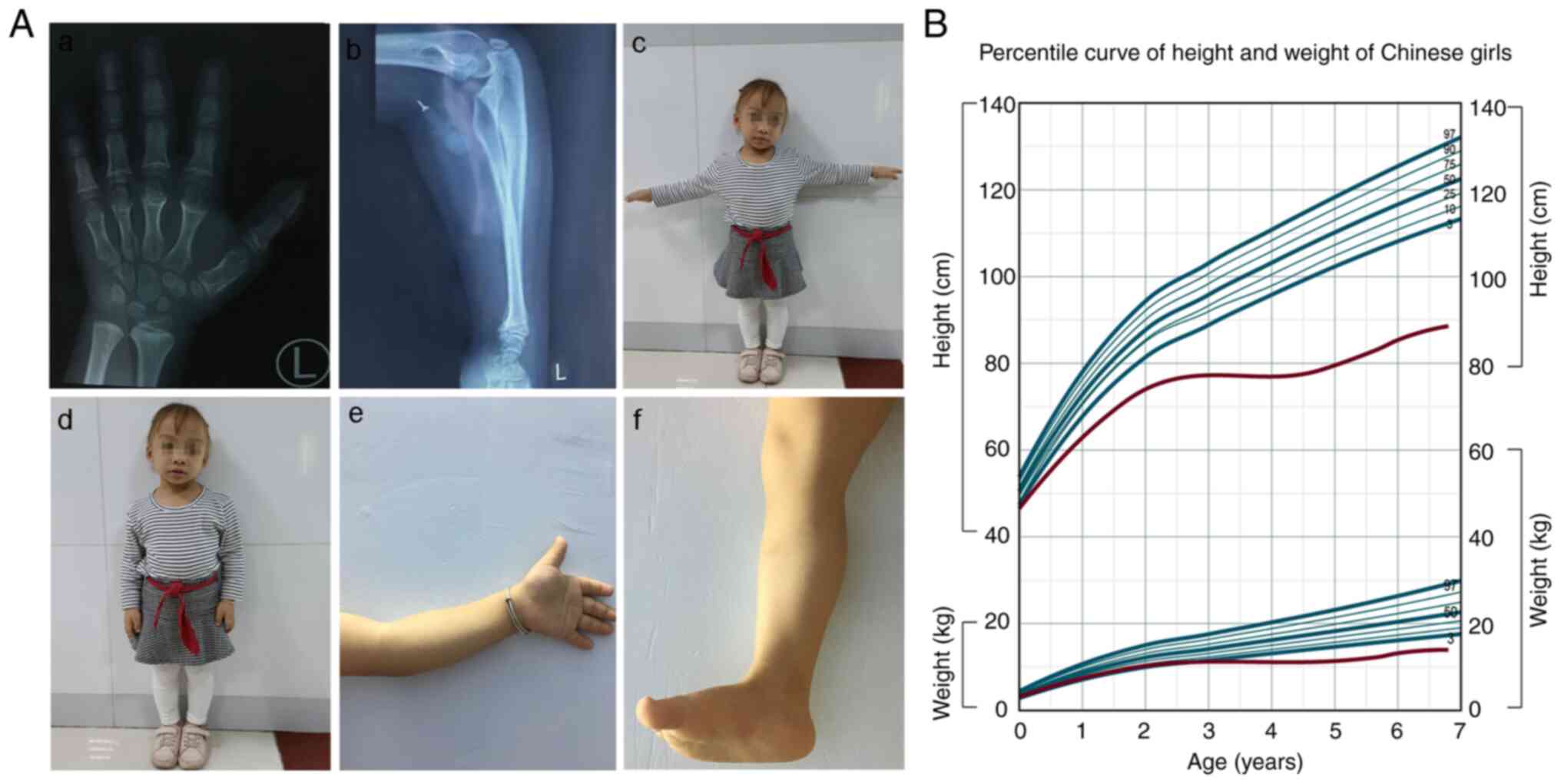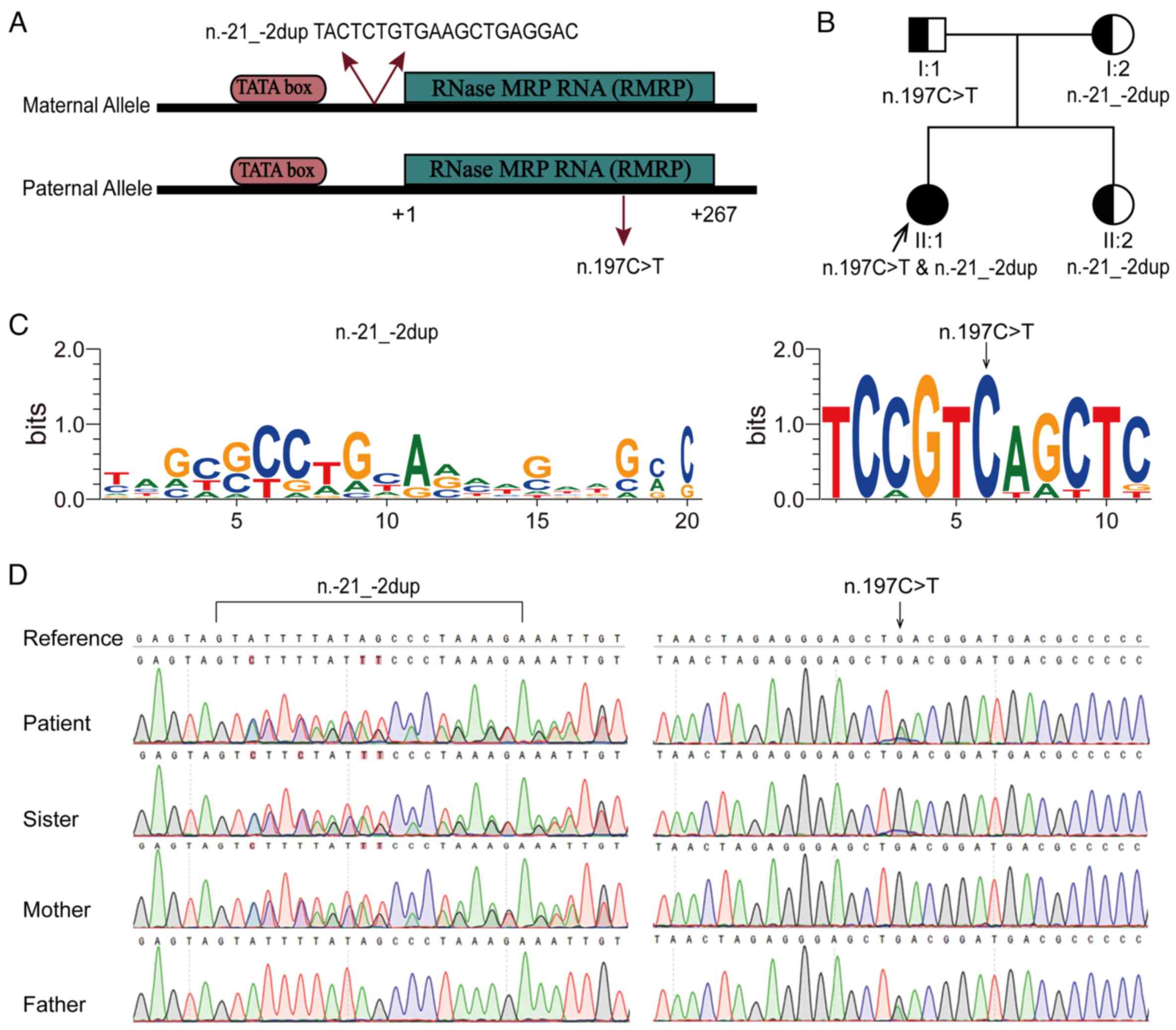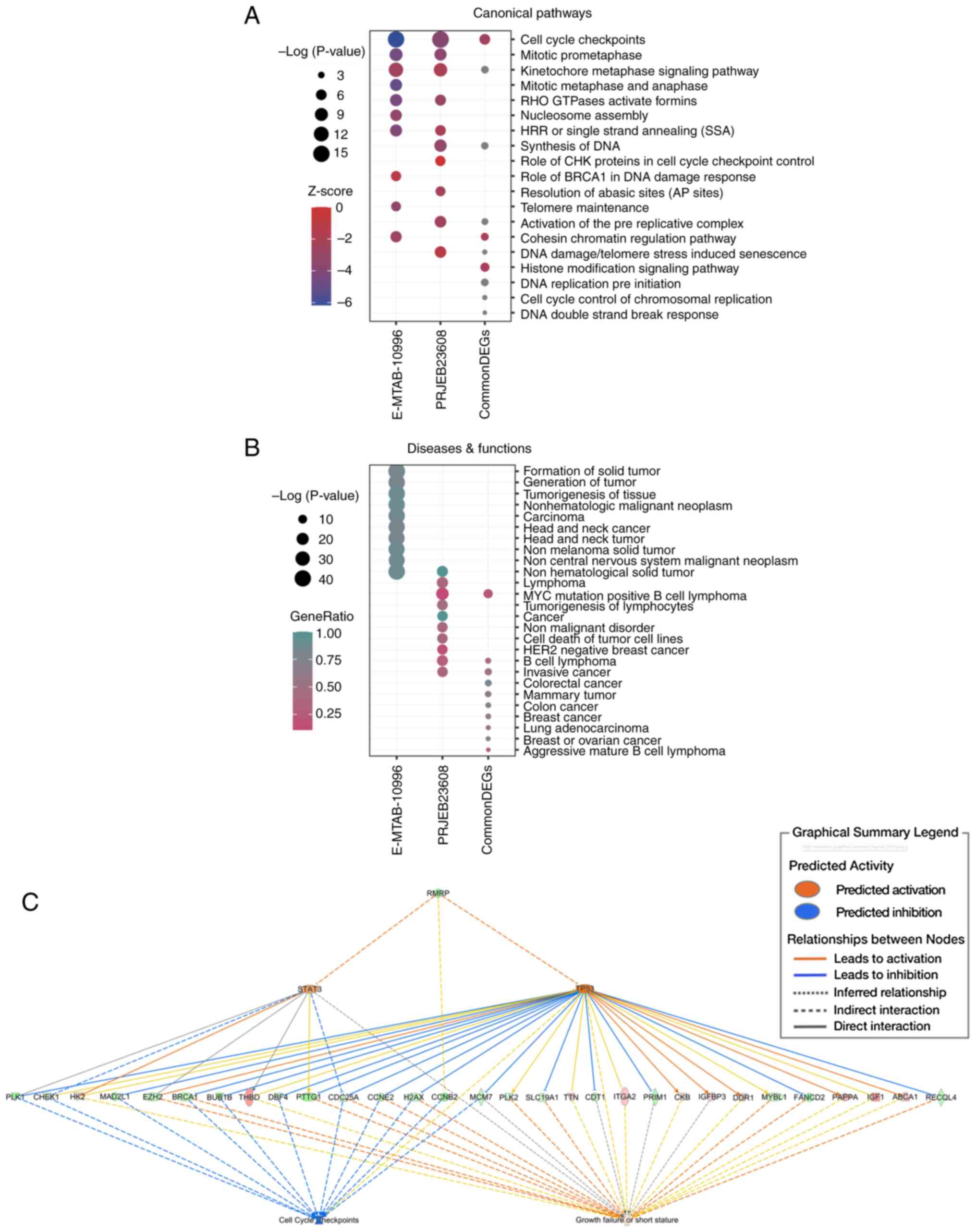|
1
|
Online Mendelian Inheritance in Man and
OMIM®, . MIM Number: 250250. Johns Hopkins University; Baltimore,
MD, USA: https://omim.org/entry/250250October 16–2022
|
|
2
|
Hussen BM, Azimi T, Hidayat HJ, Taheri M
and Ghafouri-Fard S: Long non-coding RNA RMRP in the pathogenesis
of human disorders. Front Cell Dev Biol. 9:6765882021. View Article : Google Scholar : PubMed/NCBI
|
|
3
|
Kavadas FD, Giliani S, Gu Y, Mazzolari E,
Bates A, Pegoiani E, Roifman CM and Notarangelo LD: Variability of
clinical and laboratory features among patients with ribonuclease
mitochondrial RNA processing endoribonuclease gene mutations. J
Allergy Clin Immunol. 122:1178–1184. 2008. View Article : Google Scholar : PubMed/NCBI
|
|
4
|
Vakkilainen S, Taskinen M, Klemetti P,
Pukkala E and Mäkitie O: A 30-year prospective follow-up study
reveals risk factors for early death in cartilage-hair hypoplasia.
Front Immunol. 10:15812019. View Article : Google Scholar : PubMed/NCBI
|
|
5
|
Vakkilainen S, Klemetti P, Martelius T,
Seppänen MJ, Mäkitie O and Toiviainen-Salo S: Pulmonary follow-up
imaging in cartilage-hair hypoplasia: A prospective cohort study. J
Clin Immunol. 41:1064–1071. 2021. View Article : Google Scholar : PubMed/NCBI
|
|
6
|
Mattijssen S, Welting TJ and Pruijn GJ:
RNase MRP and disease. Wiley Interdiscip Rev RNA. 1:102–116. 2010.
View Article : Google Scholar : PubMed/NCBI
|
|
7
|
Thiel CT and Rauch A: The molecular basis
of the cartilage-hair hypoplasia-anauxetic dysplasia spectrum. Best
Pract Res Clin Endocrinol Metab. 25:131–142. 2011. View Article : Google Scholar : PubMed/NCBI
|
|
8
|
Hermanns P, Tran A, Munivez E, Carter S,
Zabel B, Lee B and Leroy JG: RMRP mutations in cartilage-hair
hypoplasia. Am J Med Genet A. 140:2121–2130. 2006. View Article : Google Scholar : PubMed/NCBI
|
|
9
|
Ridanpää M, van Eenennaam H, Pelin K,
Chadwick R, Johnson C, Yuan B, vanVenrooij W, Pruijn G, Salmela R,
Rockas S, et al: Mutations in the RNA component of RNase MRP cause
a pleiotropic human disease, cartilage-hair hypoplasia. Cell.
104:195–203. 2001. View Article : Google Scholar : PubMed/NCBI
|
|
10
|
Robertson N, Shchepachev V, Wright D,
Turowski TW, Spanos C, Helwak A, Zamoyska R and Tollervey D: A
disease-linked lncRNA mutation in RNase MRP inhibits ribosome
synthesis. Nat Commun. 13:6492022. View Article : Google Scholar : PubMed/NCBI
|
|
11
|
Thiel CT, Mortier G, Kaitila I, Reis A and
Rauch A: Type and level of RMRP functional impairment predicts
phenotype in the cartilage hair hypoplasia-anauxetic dysplasia
spectrum. Am J Hum Genet. 81:519–529. 2007. View Article : Google Scholar : PubMed/NCBI
|
|
12
|
Tan R; BC Children's Hospital Members, ;
Rozmus J, Turvey SE and Biggs CM: Homozygous RMRP promoter
duplications cause severely reduced transcript abundance and SCID
associated with cartilage hair hypoplasia. J Clin Immunol.
43:1139–1142. 2023. View Article : Google Scholar : PubMed/NCBI
|
|
13
|
Nakashima E, Tran JR, Welting TJM, Pruijn
GJM, Hirose Y, Nishimura G, Ohashi H, Schurman SH, Cheng J,
Candotti F, et al: Cartilage hair hypoplasia mutations that lead to
RMRP promoter inefficiency or RNA transcript instability. Am J Med
Genet A. 143A:2675–2681. 2007. View Article : Google Scholar : PubMed/NCBI
|
|
14
|
Vakkilainen S, Skoog T, Einarsdottir E,
Middleton A, Pekkinen M, Öhman T, Katayama S, Krjutškov K, Kovanen
PE, Varjosalo M, et al: The human long non-coding RNA gene RMRP has
pleiotropic effects and regulates cell-cycle progression at G2. Sci
Rep. 9:137582019. View Article : Google Scholar : PubMed/NCBI
|
|
15
|
Chabronova A, van den Akker GGH,
Meekels-Steinbusch MMF, Friedrich F, Cremers A, Surtel DAM, Peffers
MJ, van Rhijn LW, Lausch E, Zabel B, et al: Uncovering pathways
regulating chondrogenic differentiation of CHH fibroblasts.
Noncoding RNA Res. 6:211–224. 2021. View Article : Google Scholar : PubMed/NCBI
|
|
16
|
Krämer A, Green J, Pollard J Jr and
Tugendreich S: Causal analysis approaches in ingenuity pathway
analysis. Bioinformatics. 30:523–530. 2014. View Article : Google Scholar : PubMed/NCBI
|
|
17
|
Miller DT, Lee K, Abul-Husn NS, Amendola
LM, Brothers K, Chung WK, Gollob MH, Gordon AS, Harrison SM,
Hershberger RE, et al: ACMG SF v3.1 list for reporting of secondary
findings in clinical exome and genome sequencing: A policy
statement of the American college of medical genetics and genomics
(ACMG). Genet Med. 24:1407–1414. 2022. View Article : Google Scholar : PubMed/NCBI
|
|
18
|
Miller DT, Lee K, Abul-Husn NS, Amendola
LM, Brothers K, Chung WK, Gollob MH, Gordon AS, Harrison SM,
Hershberger RE, et al: ACMG SF v3.2 list for reporting of secondary
findings in clinical exome and genome sequencing: A policy
statement of the American college of medical genetics and genomics
(ACMG). Genet Med. 25:1008662023. View Article : Google Scholar : PubMed/NCBI
|
|
19
|
Crooks GE, Hon G, Chandonia JM and Brenner
SE: WebLogo: A sequence logo generator. Genome Res. 14:1188–1190.
2004. View Article : Google Scholar : PubMed/NCBI
|
|
20
|
Dilmac S, Kuscu N, Caner A, Yildirim S,
Yoldas B, Farooqi AA and Tanriover G: SIRT1/FOXO signaling pathway
in breast cancer progression and metastasis. Int J Mol Sci.
23:102272022. View Article : Google Scholar : PubMed/NCBI
|
|
21
|
Harada D, Yamanaka Y, Ueda K, Shimizu J,
Inoue M, Seino Y and Tanaka H: An effective case of growth hormone
treatment on cartilage-hair hypoplasia. Bone. 36:317–322. 2005.
View Article : Google Scholar : PubMed/NCBI
|
|
22
|
Ridanpää M, Sistonen P, Rockas S, Rimoin
DL, Mäkitie O and Kaitila I: Worldwide mutation spectrum in
cartilage-hair hypoplasia: ancient founder origin of the
major70A->G mutation of the untranslated RMRP. Eur J Hum Genet.
10:439–447. 2002. View Article : Google Scholar : PubMed/NCBI
|
|
23
|
Bonafé L, Dermitzakis ET, Unger S,
Greenberg CR, Campos-Xavier BA, Zankl A, Ucla C, Antonarakis SE,
Superti-Furga A and Reymond A: Evolutionary comparison provides
evidence for pathogenicity of RMRP mutations. PLoS Genet.
1:e472005. View Article : Google Scholar : PubMed/NCBI
|
|
24
|
Bonafé L, Schmitt K, Eich G, Giedion A and
Superti-Furga A: RMRP gene sequence analysis confirms a
cartilage-hair hypoplasia variant with only skeletal manifestations
and reveals a high density of single-nucleotide polymorphisms. Clin
Genet. 61:146–151. 2002. View Article : Google Scholar : PubMed/NCBI
|
|
25
|
Gomes ME, Calatrava Paternostro L, Moura
VR, Antunes D, Caffarena ER, Horovitz D, Sanseverino MT, Ferraz
Leal G, Felix TM, Pontes Cavalcanti D, et al: Identification of
novel and recurrent RMRP variants in a series of brazilian patients
with cartilage-hair hypoplasia: McKusick syndrome. Mol Syndromol.
10:255–263. 2020. View Article : Google Scholar : PubMed/NCBI
|
|
26
|
Hunt SE, Moore B, Amode RM, Armean IM,
Lemos D, Mushtaq A, Parton A, Schuilenburg H, Szpak M, Thormann A,
et al: Annotating and prioritizing genomic variants using the
ensembl variant effect predictor-A tutorial. Hum Mutat. 43:986–997.
2022. View Article : Google Scholar : PubMed/NCBI
|
|
27
|
Vakkilainen S, Mäkitie R, Klemetti P,
Valta H, Taskinen M, Husebye ES and Mäkitie O: A wide spectrum of
autoimmune manifestations and other symptoms suggesting immune
dysregulation in patients with cartilage-hair hypoplasia. Front
Immunol. 9:24682018. View Article : Google Scholar : PubMed/NCBI
|
|
28
|
Gamliel A, Lee YN, Lev A, AbuZaitun O,
Rechavi E, Levy S, Simon AJ and Somech R: Immunologic heterogeneity
in 2 cartilage-hair hypoplasia patients with a distinct clinical
course. J Investig Allergol Clin Immunol. 33:263–270. 2022.
View Article : Google Scholar : PubMed/NCBI
|
|
29
|
Vakkilainen S, Taskinen M and Mäkitie O:
Immunodeficiency in cartilage-hair hypoplasia: Pathogenesis,
clinical course and management. Scand J Immunol. 92:e129132020.
View Article : Google Scholar : PubMed/NCBI
|
|
30
|
Hermanns P, Bertuch AA, Bertin TK, Dawson
B, Schmitt ME, Shaw C, Zabel B and Lee B: Consequences of mutations
in the non-coding RMRP RNA in cartilage-hair hypoplasia. Hum Mol
Genet. 14:3723–3740. 2005. View Article : Google Scholar : PubMed/NCBI
|
|
31
|
Yeganeh M and Hernandez N: RNA polymerase
III transcription as a disease factor. Genes Dev. 34:865–882. 2020.
View Article : Google Scholar : PubMed/NCBI
|
|
32
|
Vaddavalli PL and Schumacher B: The p53
network: Cellular and systemic DNA damage responses in cancer and
aging. Trends Genet. 38:598–612. 2022. View Article : Google Scholar : PubMed/NCBI
|
|
33
|
Levine AJ: p53: 800 Million years of
evolution and 40 years of discovery. Nat Rev Cancer. 20:471–480.
2020. View Article : Google Scholar : PubMed/NCBI
|
|
34
|
Salvador G, Sanmarti R, Garcia-Peiró A,
Rodríguez-Cros JR, Muñoz-Gómez J and Cañete JD: p53 expression in
rheumatoid and psoriatic arthritis synovial tissue and association
with joint damage. Ann Rheum Dis. 64:183–187. 2005. View Article : Google Scholar : PubMed/NCBI
|
|
35
|
Taghadosi M, Adib M, Jamshidi A, Mahmoudi
M and Farhadi E: The p53 status in rheumatoid arthritis with focus
on fibroblast-like synoviocytes. Immunol Res. 69:225–238. 2021.
View Article : Google Scholar : PubMed/NCBI
|
|
36
|
Xiao CY, Pan YF, Guo XH, Wu YQ, Gu JR and
Cai DZ: Expression of β-catenin in rheumatoid arthritis
fibroblast-like synoviocytes. Scand J Rheumatol. 40:26–33. 2011.
View Article : Google Scholar : PubMed/NCBI
|
|
37
|
Sun X, Zhang R, Liu M, Chen H, Chen L, Luo
F, Zhang D, Huang J, Li F, Ni Z, et al: Rmrp mutation disrupts
chondrogenesis and bone ossification in zebrafish model of
cartilage-hair hypoplasia via enhanced Wnt/β-catenin signaling. J
Bone Miner Res. 34:2101–2116. 2019. View Article : Google Scholar : PubMed/NCBI
|
|
38
|
Ruscitto A, Chen P, Tosa I, Wang Z, Zhou
G, Safina I, Wei R, Morel MM, Koch A, Forman M, et al:
Lgr5-expressing secretory cells form a Wnt inhibitory niche in
cartilage critical for chondrocyte identity. Cell Stem Cell.
30:1179–1198.e7. 2023. View Article : Google Scholar : PubMed/NCBI
|
|
39
|
Ding L, Jiang Z, Wu J, Li D, Wang H, Lu W,
Zeng Q and Xu G: β-catenin signaling inhibits cartilage endplate
chondrocyte homeostasis in vitro. Mol Med Rep. 20:567–572.
2019.PubMed/NCBI
|
|
40
|
Xuan F, Yano F, Mori D, Chijimatsu R,
Maenohara Y, Nakamoto H, Mori Y, Makii Y, Oichi T, Taketo MM, et
al: Wnt/β-catenin signaling contributes to articular cartilage
homeostasis through lubricin induction in the superficial zone.
Arthritis Res Ther. 21:2472019. View Article : Google Scholar : PubMed/NCBI
|
|
41
|
Bolduc JA, Collins JA and Loeser RF:
Reactive oxygen species, aging and articular cartilage homeostasis.
Free Radic Biol Med. 132:73–82. 2019. View Article : Google Scholar : PubMed/NCBI
|
|
42
|
Usher KM, Zhu S, Mavropalias G, Carrino
JA, Zhao J and Xu J: Pathological mechanisms and therapeutic
outlooks for arthrofibrosis. Bone Res. 7:92019. View Article : Google Scholar : PubMed/NCBI
|
|
43
|
Zhang W, Robertson WB, Zhao J, Chen W and
Xu J: Emerging trend in the pharmacotherapy of osteoarthritis.
Front Endocrinol (Lausanne). 10:4312019. View Article : Google Scholar : PubMed/NCBI
|
|
44
|
Gu J, Rao W, Huo S, Fan T, Qiu M, Zhu H,
Chen D and Sheng X: MicroRNAs and long non-coding RNAs in cartilage
homeostasis and osteoarthritis. Front Cell Dev Biol.
10:10927762022. View Article : Google Scholar : PubMed/NCBI
|
|
45
|
Young DA, Barter MJ and Soul J:
Osteoarthritis year in review: Genetics, genomics, epigenetics.
Osteoarthritis Cartilage. 30:216–225. 2022. View Article : Google Scholar : PubMed/NCBI
|
|
46
|
Zhu J, Yu W, Wang Y, Xia K, Huang Y, Xu A,
Chen Q, Liu B, Tao H, Li F and Liang C: lncRNAs: Function and
mechanism in cartilage development, degeneration, and regeneration.
Stem Cell Res Ther. 10:3442019. View Article : Google Scholar : PubMed/NCBI
|
|
47
|
Steinbusch MMF, Caron MMJ, Surtel DAM,
Friedrich F, Lausch E, Pruijn GJM, Verhesen W, Schroen BLM, van
Rhijn LW, Zabel B and Welting TJM: Expression of RMRP RNA is
regulated in chondrocyte hypertrophy and determines chondrogenic
differentiation. Sci Rep. 7:64402017. View Article : Google Scholar : PubMed/NCBI
|
|
48
|
Rogler LE, Kosmyna B, Moskowitz D, Bebawee
R, Rahimzadeh J, Kutchko K, Laederach A, Notarangelo LD, Giliani S,
Bouhassira E, et al: Small RNAs derived from lncRNA RNase MRP have
gene-silencing activity relevant to human cartilage-hair
hypoplasia. Hum Mol Genet. 23:368–382. 2014. View Article : Google Scholar : PubMed/NCBI
|
|
49
|
Milacic M, Beavers D, Conley P, Gong C,
Gillespie M, Griss J, Haw R, Jassal B, Matthews L, May B, et al:
The reactome pathway knowledgebase 2024. Nucleic Acids Res. 52(D1):
D672–D678. 2024. View Article : Google Scholar : PubMed/NCBI
|
|
50
|
Li S, Wang L, Wang Y, Zhang C, Hong Z and
Han Z: The synthetic lethality of targeting cell cycle checkpoints
and PARPs in cancer treatment. J Hematol Oncol. 15:1472022.
View Article : Google Scholar : PubMed/NCBI
|
|
51
|
Matthews HK, Bertoli C and de Bruin RAM:
Cell cycle control in cancer. Nat Rev Mol Cell Biol. 23:74–88.
2022. View Article : Google Scholar : PubMed/NCBI
|
|
52
|
Obara-Moszynska M, Wielanowska W, Rojek A,
Wolnik-Brzozowska D and Niedziela M: Treatment of cartilage-hair
hypoplasia with recombinant human growth hormone. Pediatr Int.
55:e162–e164. 2013. View Article : Google Scholar : PubMed/NCBI
|
|
53
|
Hokken-Koelega ACS, van der Steen M,
Boguszewski MCS, Cianfarani S, Dahlgren J, Horikawa R, Mericq V,
Rapaport R, Alherbish A, Braslavsky D, et al: International
consensus guideline on small for gestational age: Etiology and
management from infancy to early adulthood. Endocr Rev. 44:539–565.
2023. View Article : Google Scholar : PubMed/NCBI
|
|
54
|
Capital Institute of Pediatrics and The
Coordinating Study Group of Nine Cities on the Physical Growth and
Development of Children, . A national survey on physical growth and
development of children under seven years of age in nine cities of
China in 2015. Zhonghua Er Ke Za Zhi. 56:192–199. 2018.(In
Chinese). PubMed/NCBI
|














